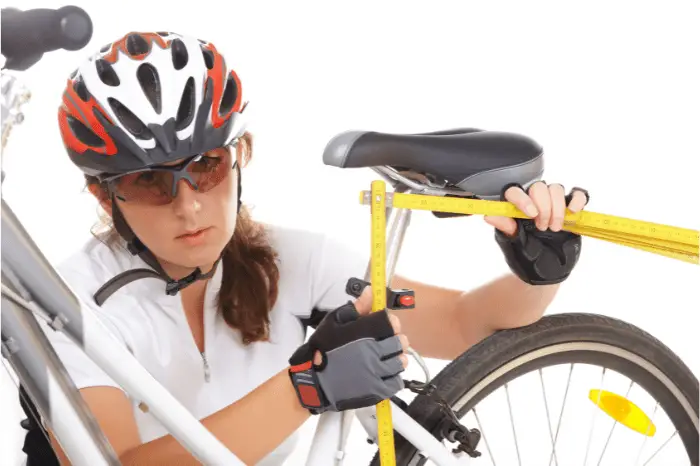
Choosing the right bike size is crucial for both comfort and performance. One of the most important factors to consider when sizing a bike is the rider’s inseam measurement. An accurate inseam measurement helps determine the appropriate bike frame size, ensuring a comfortable and efficient riding experience.
Measuring your inseam correctly is key to finding the perfect bike fit. Inseam measurements can be taken at home against a wall or closed door, preferably with the help of a large hardcover book or notebook, a tape measure, and a pencil. With bike shoes on, simply straddle the book like a saddle and mark where the book’s spine meets the wall. The measurement from the mark to the floor represents your inseam.
Once you have an accurate inseam measurement, various formulas can be used to calculate the correct frame size for different types of bikes such as mountain, road, or hybrid bikes. For example, mountain bikes use the formula: inseam (in cm) x 0.66, while road bikes use the formula: inseam (in cm) x 0.70.
Key Takeaways
- Proper bike sizing starts with an accurate inseam measurement
- Use a specific formula depending on the type of bike, such as mountain or road bikes
- A well-fitted bike leads to a more comfortable and efficient riding experience
Measuring Your Inseam
In order to find the right bike size for you, it’s essential to accurately measure your inseam. This section will guide you through the process of measuring your inseam, which is the distance from the floor to your crotch.
Proper Stance
First, stand straight with your back against a wall or a closed door. This will help ensure you’re standing straight for accurate measurements. Remove your shoes and position your feet about 6 to 8 inches (15.24 cm – 20.32 cm) apart.
Tools Required
To measure your inseam, you will need just a few basic items:
- Tape measure
- A book or a flat, rigid object
- A pencil or pen
Step-by-Step Guide
- Place the book: Hold the book with its spine upwards and wedge it between your legs, in contact with your crotch as if you were sitting on a bike saddle. Make sure the book is level and pressed firmly against your body.
- Mark the height: With the book in position, use a pencil or pen to mark the wall at the top corner of the book. This will create a clear reference point for measuring your inseam.
- Measure the distance: Use a tape measure to measure the distance from the floor to the marked point on the wall. Be sure to measure along the wall, keeping the tape measure straight and level. Record your measurement in both centimeters and inches. This value is your inseam measurement.
Now that you have your inseam measurement, it can be used to determine the appropriate bike frame size for your specific needs. Different bike sizing charts are available to help you find the right bike size for different types of bikes, such as road bikes, mountain bikes, and city bikes. Remember that bike sizes for men and women might differ, so always refer to the recommended size chart for your gender.
Determining Bike Size
Bike Size Charts
To get the most accurate bike size, you can refer to bike size charts that are based on your height and/or inseam measurements. These charts usually provide the proper frame size in inches or centimeters. Keep in mind that different types of bikes may require different sizing charts, such as road bikes, mountain bikes, or hybrid bikes.
Manufacturer Specifications
Another way to determine the right bike size is to check the manufacturer’s specifications or recommendations. Many bike brands provide their own specific sizing charts on their websites, taking into account factors like frame geometry and rider preferences.
Make sure you’re looking at the sizing information for the exact model and type of bike you’re interested in purchasing.
Adjustments for Riding Style

Once you have a general idea of the appropriate bike size, consider making adjustments based on your riding style. For example, if you prefer a more aggressive, performance-oriented riding position, you might opt for a slightly smaller frame size. Conversely, if comfort is your primary concern, you may choose a slightly larger frame.
Here’s a quick guide for making adjustments:
- Road Bikes: For a performance fit, subtract 1-2cm from your ideal frame size. For a more relaxed fit, add 1-2cm.
- Mountain Bikes: Opt for a smaller frame size if you ride on technical terrain or want better handling. Choose a larger frame for increased stability on descents and smoother trails.
- Hybrid Bikes: Adjust frame size based on your desired balance between comfort and performance.
By referring to bike size charts, checking manufacturer specifications, and making adjustments for your riding preferences, you can find a bike that fits you comfortably and suits your needs.
Adjusting the Bike to Fit
Once you have determined your bike size based on your inseam, it is important to adjust certain parts of the bike to achieve maximum comfort, efficiency, and overall fit. In this section, we will discuss three essential adjustments: Saddle Height, Saddle Position, and Handlebar Height.
Saddle Height

Proper saddle height is crucial for comfort and pedaling efficiency. To find the right height for you, follow these simple steps:
- Sit on the bike, either on a trainer or with the help of a friend holding it steady.
- Place your heel on the pedal and fully extend your knee with one foot at the lowest pedal position.
- Adjust the saddle height until your leg is straight, without having to tilt your hips to reach the pedal.
Your saddle height is now adjusted correctly for you, and when you pedal using the balls of your feet, your knees should have a slight bend at the lowest position.
Saddle Position
Saddle position (fore and aft) plays a significant role in your comfort and pedaling efficiency. To set the ideal saddle position:
- Sit on the bike, as if you were riding it, and place the balls of your feet on the pedals.
- With one pedal in the 3 o’clock position, place the end of a plumb line or a string with a weight on it against the front of your knee.
- The line should run straight down to the pedal axle.
If the line is too far forward or backward, move the saddle accordingly, and re-check your position until the plumb line runs straight down to the pedal axle.
Handlebar Height
Lastly, handlebar height is crucial for proper body position and control on the bike. The appropriate handlebar height varies depending on the type of bike and personal preference. Here’s a general guideline:
- Road bikes: The handlebars should be roughly level with the saddle, or slightly lower for a more aggressive riding position.
- Mountain bikes: Handlebars should be higher than the saddle for better control on descents and technical terrain.
- City bikes: The handlebars should be higher than the saddle for a more upright, comfortable riding position.
To adjust the handlebar height, loosen the stem bolts or the headset spacers and raise or lower the handlebars to your preferred height, making sure all cables and housing are not being stretched or pinched. Once you’ve found the right height for you, securely tighten the stem bolts or headset spacers.
By following these guidelines, you’ll have a bike that fits well and offers a more comfortable and efficient riding experience. Remember that adjustments can always be fine-tuned and tailored to your specific needs and preferences as you gain more experience on your bike.
Common Mistakes to Avoid
Ignoring Saddle Width
One common mistake when measuring inseam for bike sizing is ignoring saddle width. Choosing the right saddle width is essential for comfort and stability while cycling. To determine the appropriate saddle width, follow these steps:
- Sit on a flat surface: Place a sturdy cardboard or piece of paper on a flat surface, sit on it with your feet on the ground, and your legs slightly apart.
- Measure your sit bone distance: Using a soft tape measure or ruler, measure the distance between the two widest points left by your sit bones.
- Choose the right saddle width: Opt for a saddle that is slightly wider than your measured sit bone distance.
Note: Some bike shops offer saddle width measuring devices or gel pads for accurate measurements.
Overlooking Handlebar Reach
Another mistake to avoid is overlooking the handlebar reach, which can lead to discomfort, fatigue, and potential injury. Handlebar reach refers to the distance from your saddle to the handlebars. Factors affecting handlebar reach include the bike’s frame size and the stem length. Balance your comfort, body position, and handling by considering the following guidelines:
- Road bikes: Aim for a handlebar reach that allows a slight bend in your elbows when gripping the hoods or tops.
- Mountain bikes: Choose a reach that lets you maintain a neutral back position and maintain control over rough terrain.
- Hybrid bikes: Opt for a more relaxed reach, allowing for increased comfort during casual or commuting rides.
Forgetting Pedal Position
Finally, don’t forget about pedal position when measuring your inseam for bike sizing. Proper pedal position ensures efficient power transfer and minimizes the risk of knee pain. Consider the following tips for optimal pedal position:
- Pedal spindle: Align the ball of your foot with the center of the pedal spindle for efficient power transfer.
- Cleats (if applicable): Adjust the cleat position to suit your riding style and biomechanics, ensuring a comfortable and safe ride.
- Pedal float: If using clipless pedals, choose a pedal system with an appropriate amount of float — the degree of freedom your foot has while clipped into the pedal — to accommodate your natural foot rotation during the pedal stroke.
By avoiding these common mistakes, you’ll ensure a more comfortable and safe cycling experience, tailored to your unique needs.
Final Considerations
Test Riding
After determining the appropriate bike size based on your inseam, it’s essential to test ride different bikes to find the one that feels the most comfortable and secure. When test riding, adjust the saddle height to match your leg length, and try various riding positions. Take note of the bike’s handling, turning, and overall feel.
Key factors to consider while test riding:
- Comfort: Ensure the bike feels comfortable when sitting and riding.
- Handling: The bike should feel stable and responsive while steering and maneuvering.
- Braking: Test the effectiveness and responsiveness of the brakes.
Remember, even bikes with similar sizes from different manufacturers can feel different. Give yourself enough time to explore various options and find the best fit.
Expert Fitting Services
While using your inseam measurement as a starting point is a reliable method to find the right bike size, it’s worth considering expert fitting services for a tailored approach that accounts for all aspects of your body and riding preferences.
These services often analyze your body’s dimensions, flexibility, and riding style to recommend the perfect bike geometry and adjustments for you. By investing in an expert fitting, you can maximize your cycling experience, prevent injuries and enjoy better performance.
To summarize, always test ride bikes within your size range and consider expert fitting services for a precise fit. A well-fitted bike will enhance your cycling experience, ensuring comfort, safety, and confidence on the road.
